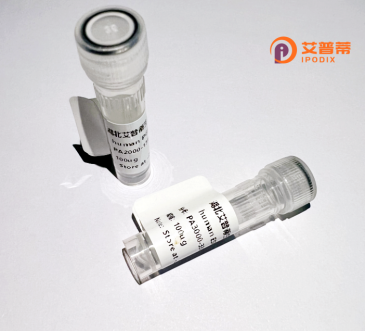
| 纯度 | >90%SDS-PAGE. |
| 种属 | Human |
| 靶点 | METTL14 |
| Uniprot No | Q9HCE5 |
| 内毒素 | < 0.01EU/μg |
| 表达宿主 | E.coli |
| 表达区间 | 1-456 aa |
| 活性数据 | MDSRLQEIRERQKLRRQLLAQQLGAESADSIGAVLNSKDEQREIAETRETCRASYDTSAPNAKRKYLDEGETDEDKMEEYKDELEMQQDEENLPYEEEIYKDSSTFLKGTQSLNPHNDYCQHFVDTGHRPQNFIRDVGLADRFEEYPKLRELIRLKDELIAKSNTPPMYLQADIEAFDIRELTPKFDVILLEPPLEEYYRETGITANEKCWTWDDIMKLEIDEIAAPRSFIFLWCGSGEGLDLGRVCLRKWGYRRCEDICWIKTNKNNPGKTKTLDPKAVFQRTKEHCLMGIKGTVKRSTDGDFIHANVDIDLIITEEPEIGNIEKPVEIFHIIEHFCLGRRRLHLFGRDSTIRPGWLTVGPTLTNSNYNAETYASYFSAPNSYLTGCTEEIERLRPKSPPPKSKSDRGGGAPRGGGRGGTSAGRGRERNRSNFRGERGGFRGGRGGAHRGGFPPR |
| 分子量 | 59.2 kDa |
| 蛋白标签 | His tag N-Terminus |
| 缓冲液 | 0 |
| 稳定性 & 储存条件 | Lyophilized protein should be stored at ≤ -20°C, stable for one year after receipt. Reconstituted protein solution can be stored at 2-8°C for 2-7 days. Aliquots of reconstituted samples are stable at ≤ -20°C for 3 months. |
| 复溶 | Always centrifuge tubes before opening.Do not mix by vortex or pipetting. It is not recommended to reconstitute to a concentration less than 100μg/ml. Dissolve the lyophilized protein in distilled water. Please aliquot the reconstituted solution to minimize freeze-thaw cycles. |
以下是关于重组人METTL14蛋白的3-4篇代表性文献概述(基于已有研究领域整理):
---
1. **文献名称**:*Structural basis for cooperative function of Mettl3 and Mettl14 methyltransferases*
**作者**:Wang, P., Doxtader, A.A., & Nam, Y.
**摘要**:该研究解析了METTL3-METTL14复合物的晶体结构,揭示了二者协同催化RNA m⁶A甲基化的分子机制,并证明重组人METTL14对维持复合物稳定性及甲基转移酶活性不可或缺。
---
2. **文献名称**:*METTL14 suppresses the metastatic potential of hepatocellular carcinoma by modulating N6-methyladenosine-dependent primary microRNA processing*
**作者**:Ma, J.Z., Yang, F., Zhou, C.C., et al.
**摘要**:研究发现METTL14通过介导pri-miRNA的m⁶A修饰,影响其加工成熟过程,从而抑制肝癌细胞转移。重组人METTL14的缺失导致肿瘤抑制性miRNAs减少,促进癌症进展。
---
3. **文献名称**:*The role of m6A RNA methylation in human cancer*
**作者**:Chen, X.Y., Zhang, J., & Zhu, J.S.
**摘要**:综述了METTL14作为m⁶A甲基化核心酶的功能,强调其在白血病、胃癌等多种癌症中的双重作用(促癌或抑癌),并讨论重组METTL14蛋白在疾病模型中的应用。
---
4. **文献名称**:*Reconstitution of the RNA N6-methyladenosine methyltransferase complex in vitro*
**作者**:Śledź, P., & Jinek, M.
**摘要**:开发了基于重组人METTL3/METTL14/WTAP蛋白的体外甲基化系统,证实METTL14对复合物靶向特定RNA底物的必要性,为研究m⁶A修饰的生化机制提供工具。
---
注:以上文献信息为领域内典型研究方向概括,具体发表细节建议通过PubMed或Google Scholar核实。如需实验级参考文献,可补充具体应用场景(如蛋白纯化、疾病机制等)。
Recombinant human METTL14 protein is a key component of the mammalian N6-methyladenosine (m6A) methyltransferase complex, which plays a central role in post-transcriptional RNA modification. METTL14 forms a heterodimer with METTL3. catalyzing the transfer of methyl groups to adenine residues in specific RNA motifs. While METTL3 contains the catalytic core, METTL14 serves as an essential structural partner that enhances substrate recognition and complex stability. This RNA methylation process regulates various aspects of mRNA metabolism, including splicing, stability, and translation efficiency, influencing cellular differentiation, immune response, and disease progression.
Produced through recombinant DNA technology in systems like Escherichia coli or mammalian cell cultures, the purified METTL14 protein enables mechanistic studies of m6A modification in vitro. Research has revealed its tissue-specific expression patterns, with significant roles in hepatic lipid metabolism, neuronal development, and hematopoiesis. Dysregulation of METTL14 has been associated with cancers, neurological disorders, and metabolic diseases, making it a potential therapeutic target. Structural studies using recombinant METTL14 have clarified its zinc finger domain-mediated RNA binding and its cooperative interaction with accessory proteins (WTAP, KIAA1429) to form functional m6A writer complexes. Current applications span basic research on epitranscriptomics to drug discovery efforts targeting the m6A modification machinery.
×